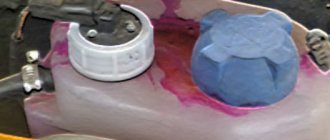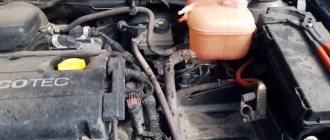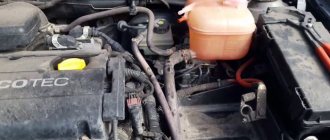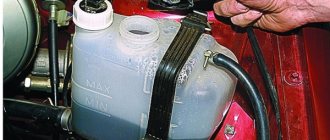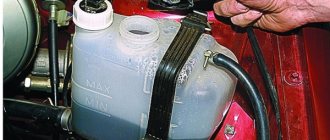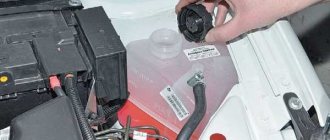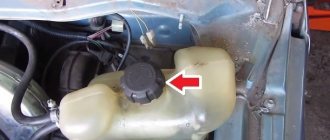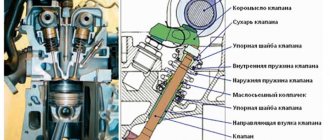Expansion tank in a car cooling system
Even a short trip by car will be impossible if the car's cooling circuits are faulty. Modern vehicles are driven by thrust generated by combustion processes. The gas-fuel mixture, entering the engine combustion chamber, disintegrates, imparting part of the released energy to the engine's CPG. Normal operation of the system is impossible if all the conditions required for uniform and stable combustion of fuel are not met.
The automotive cooling system maintains the temperature required for engine operation. Most modern vehicles are characterized by the presence of 2 types of internal combustion engine cooling - air and liquid. The engine is cooled with air thanks to the operation of fans, and the operation of liquid cooling is supported by the circulation of the cooler in the radiator circuit. The coolant enters the internal combustion engine and picks up some of the heat during the heating process, and then exits into the expansion tank, from where it is sent to the radiators for cooling.
Expansion tank - signs of malfunction and replacement
Replacing the expansion tank may be necessary if it has lost its seal, for example, burst. I had a similar situation with my tank. In the morning I went to work as usual, I get to work, I get out of the car, I look, and under it there is a puddle of antifreeze and it continues to flow out, I didn’t immediately understand what was wrong, I started inspecting the pipes, everything seemed to be in order, then I inspected the tank, and it burst almost at the very bottom, and coolant leaked out of the crack. I somehow got home, because... The liquid leaked only from the tank, and replaced it with a new one. The expansion tank bursts if the plug is faulty - it does not release excess pressure, i.e. the valve does not work.
Now, in fact, let’s move on to the process of replacing the tank on VAZ 2110-2112 cars.
Work progress:
- The first thing to do is to partially drain the coolant from the tank; you can drain it by unscrewing the drain plug on the radiator. There is no need to drain completely; as soon as the liquid leaves the tank, you can tighten the drain plug.
- After this, you need to disconnect the tank securing belt;
- Loosen the clamp on the steam exhaust hose of the engine radiator and disconnect the hose;
- Similarly, disconnect the heater radiator hose;
- Now you need to loosen the clamp on the thermostat hose of the lower pipe of the tank and remove the hose;
- After this you can remove the tank.
Installation
The tank must be installed in the reverse order. After this, fill the coolant to the level, start the engine and let it run for several minutes at high speeds to get rid of air in the system.
Advice: if your tank bursts, then after replacing it, it is better to immediately change the cap, because most likely it was she who caused its failure.
vaz2110-12.ru
Damage to the expansion tank
A car's expansion tank is usually made of off-white or black plastic. Its shape and dimensions can vary markedly depending on the make and model of the vehicle in which it is installed. There are designs of expansion tanks made of aluminum alloy, intended for tuning the engine compartment. Standard tanks have two coolant outlets and a coolant refill hole with a cap.
The technical characteristics of the cooling circuit capacity determine typical problems that may arise during the operation of automotive expansion tanks:
- Broken cooling circuit hoses.
- The inlet cover is broken.
- Destruction of the plastic case.
All three risk factors are associated with the physical impact of the coolant on the expansion tank chamber.
An aqueous solution of alcohol containing a complex of additional additives is used as a coolant. Additives ensure the most efficient heat transfer and minimize the destructive effect of the coolant on the engine. Russian retail chains of automotive chemicals will offer customers 2 types of coolant - antifreeze and antifreeze.
Antifreeze is a domestic development, differing in the types of additives and price. Antifreeze costs several times more and can provide more effective protection of the internal combustion engine from wear.
The coolant entering the expansion tank often has a fairly high temperature, and in some cases it can boil right in the plastic container. Boiling of the coolant in the expansion tank often leads to its deformation. It also happens that under the influence of heated antifreeze, the tank bursts, the cooler hoses break, or the lid of the tank is knocked out. To prevent such situations, special valve cover designs have been developed.
How to add antifreeze
Coolant is filled according to the level.
To finally make sure that the fluid level is sufficient. It is necessary to warm up the engine. The thermostat will open. This will remove air from the system. If he accumulated there. Because when the reservoir was removed there was no coolant in it. And it is not known how much of it leaked from the system. When hot, the volume of liquid increases. More fluid could come out than is in the expansion tank. You can warm up the engine at idle speed. But this will take a lot of time. Therefore, in order not to burn gasoline in vain, it is better to take liquid with you on the road for topping up. And when the thermostat opening temperature is reached. This is 80-90 degrees. Stop and add fluid to the level.
Valve cover and expansion tank sensors
Valve covers of expansion tanks are a composite mechanism of several plates, springs, locking and connecting parts. Valve cover design may vary depending on the make and model of the vehicle. Despite all the model differences, the design of any valve is extremely simple, and even a child can figure it out.
The valve cover performs the function of relieving excess pressure to protect the expansion tank body from deformation and rupture. When the pressure created by the boiling coolant inside the expansion tank reaches a critical level, then the valve on the cap opens and the excess coolant volume is released into the engine compartment. If the vehicle engine often “boils,” it is worth checking the coolant level in the system.
The fact that repair of the expansion tank cap is necessary may be indicated by frequent “boiling” of the car or the appearance of coolant stains where the vehicle is parked. The reasons for the malfunction of the cover can be very different - from metal fatigue in the design of the valve mechanism to soldering of valve parts to each other. To check its operation you will need a pressure gauge and a car pump. They must be connected to the expansion tank instead of hoses. A working cap will not allow the pressure in the tank to rise above the permissible limit.
Frequent bleeding of excess pressure in the expansion tank leads to a shortage of process fluid in the cooling system. The result of a lack of coolant in the system is regular “boiling” of the internal combustion engine and the inability to fully use the vehicle. The lack of antifreeze in the expansion tank should be indicated by the on-board computer or lights on the car’s dashboard. They read data from the float sensor in the expansion tank chamber.
Removing the expansion tank
The tank is mounted in a special bracket. There is no need to unscrew anything except the hoses that go to the tank. But it just didn't work out. The casing has a recess for the tank. The casing must be unscrewed and lifted up a little. To do this, unscrew the wiper arms. Plastic panel under the wipers. Then the casing is unscrewed. Raising the trim a little. It becomes possible to remove the expansion tank. From the bracket.
This design provides for the replacement of the Priora expansion tank with air conditioning. This car has Panasonic air conditioning. Two pipes fit into the expansion tank. Other designs may have three pipes. The parameters of the tank itself do not change.
Repair, replacement and modernization of the expansion tank
The coolant level sensor is part of the design of most expansion tanks. This is the only part of the expansion tank housing that can be repaired. In fact, all repairs to the expansion tank come down to repairing the coolant level sensor or replacing it. Any motorist who has repaired something on their car at least once in their life can change it.
Modernizing the expansion tank involves installing a modern valve cover if the design of the current one cannot perform the function of relieving pressure. If the cap was replaced due to antifreeze leaks, and after installing a new or repaired cap, the leaks did not stop, then the tank will have to be replaced. The procedure is simple and universal - replacing the expansion tank of a VAZ is not much different from replacing the tank on a foreign car.
In order to change the tank, just follow 4 steps:
- Disconnect the cooling system hoses.
- Unscrew the mounting screws, if any.
- Remove the old reservoir from the engine compartment.
- Install the new expansion tank in place of the old one, securing it with screws and connecting the hoses.
The cost of the tank is low, but can vary significantly depending on the store. It often turns out that purchasing auto parts at an auto repair shop is much cheaper than buying it at a shopping center. It would be advisable to turn to the help of a vehicle service and repair center if you don’t have the time to independently search for a tank in nearby stores, and you don’t have the desire to install it. The car service aggregator Uremont.com will help you find the nearest car service center that has the necessary parts in stock.
Repair or replace the tank?
Some drivers, having noticed that the expansion tank 2114 is leaking, try to repair the crack with glue or epoxy resin.
It should be noted right away that doing this is absolutely not worth it. After all, such repairs, as a rule, are short-lived, and with active use, even the most reliable adhesive seam can leak.
In addition, as already mentioned, the appearance of cracks in the tank is a sign of aging of the plastic caused by depolymerization - the volatilization of a number of fractions from the material that give it plasticity.
Thus, a plastic container that has already cracked can always crack again. That is why replacing the expansion tank of a VAZ 2114 is the most preferable option rather than repairing it.
As for the cover, it is also not repairable, and in case of malfunction it should be replaced with a similar one. At the same time, it is highly advisable to purchase the “native” cover for the 2114, and not its various analogues, the quality (and functionality) of which may be much worse.
If you could not find a cover for the 14th model, then instead you can purchase and install a cover for 2199, since they are completely interchangeable.
